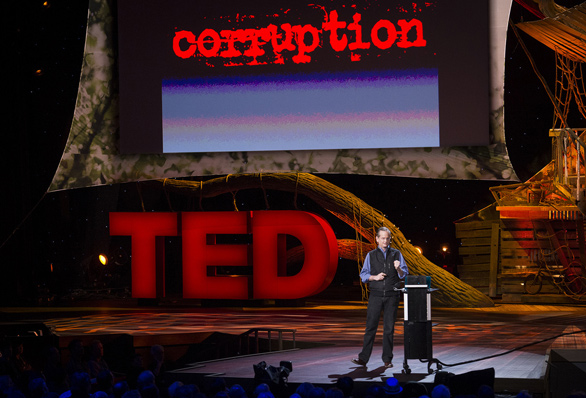
Lawrence Lessig talks about a fundamental corruption at the core of the U.S.’s political system. Photo: James Duncan Davidson
“Once upon a time, there was a place called Lesterland,” Lawrence Lessig begins today’s talk. “Of its 311 million people, it turns out 144,000 are called Lester,” Lessig says.
 Lawrence Lessig: We the People, and the Republic we must reclaim
In Lesterland, this .05% of the population is granted extraordinary power. Each election cycle, there’s a general election, in which the people get to vote, and a Lester election, in which only the Lesters can vote. “In order to run in the general election, you must do extremely well in the Lester election,” Lessig explains. “So we have a democracy, no doubt, but it’s dependent upon the Lesters and dependent upon the people. It has a competing dependency—we could say a conflicting dependency—depending on who the Lesters are.”
Lawrence Lessig: We the People, and the Republic we must reclaim
In Lesterland, this .05% of the population is granted extraordinary power. Each election cycle, there’s a general election, in which the people get to vote, and a Lester election, in which only the Lesters can vote. “In order to run in the general election, you must do extremely well in the Lester election,” Lessig explains. “So we have a democracy, no doubt, but it’s dependent upon the Lesters and dependent upon the people. It has a competing dependency—we could say a conflicting dependency—depending on who the Lesters are.”
The trick: the United States is Lesterland, only instead of the Lester election, we have the “money election.” As in Lesterland, to run in the general election, you’ve got to win with the funders first. The “relevant funders” comprise .05% of the population; in fact, Lessig says, just 132 Americans, or .000042% of the country, gave 60% of the latest Super PAC funds. So holding office has become about catering to the funders rather than the general public—and sometimes the funders’ interests run counter to everyone else’s.
Lesterland, then, provides a piercing allegory for what Lessig describes as our political system’s fundamental corruption. “The corruption I’m talking about is perfectly legal. It’s a corruption relative to the framers’ baseline for this republic,” Lessig says. “It’s a pathological, democracy-destroying corruption.”
To hear what we can do to correct this corruption, watch Lessig’s talk or read the companion TED Book, Lesterland.
Because we’re so moved by Lessig’s Lesterland analogy, below we’re rounded up more examples of allegories that have described — sometimes brilliantly, sometimes less so — political and societal problems.
- Whether or not L. Frank Baum intended for The Wonderful Wizard of Oz to be read as an allegory, it’s been interpreted as one for decades. Henry M. Littlefield wrote in 1964, “Dorothy is Baum’s Miss Everyman. She is one of us, levelheaded and human, and she has a real problem. For all the attractions of Oz, Dorothy desires only to return to the gray plains and Aunt Em and Uncle Henry … Dorothy sets out on the Yellow Brick Road wearing the Witch of the East’s magic Silver Shoes. Silver shoes walking on a golden road; henceforth Dorothy becomes the innocent agent of Baum’s ironic view of the Silver issue.” Littlefield continues dissecting the Oz storyline for its parallels to late-1800s economics and Populism, writing, “Baum created a children’s story with a symbolic allegory implicit within its story line and characterizations … The relationship and analogies outlined above are admittedly theoretical, but they are far too consistent to be coincidental.”
. - In James Cameron’s 2009 film Avatar, the Na’vi — an alien race — is threatened by invading Earthlings. It’s been analyzed as an allegory for a “surprising” range of situations, as Joshua Keating posted on Foreign Policy at the time, from the exploitation of Chinese citizens to the exploitation of an indigenous tribe in India to a justification of Obama’s Nobel Peace Prize.
. - The new documentary Room 237 argues that Stanley Kubrik’s 1980 film The Shining wasn’t just a horror film, but an intricate and meaning-laden work filled with “important and, in some cases, truly dark meanings,” per Bill Wyman on the New Yorker’s blog. What meanings, exactly? Less clear: as Wyman has it, the supposed allegories involve “the Holocaust (stemming from Nicholson’s German typewriter), the Apollo Space project, fairy tales, and more and more and more.”
. - Perhaps the paradigmatic political allegory is George Orwell’s Animal Farm, which uses, yes, a farm full of animals to depict and critique the situation in 1940s Russia. “Animal Farm was the first book in which I tried, with full consciousness of what I was doing, to fuse political purpose and artistic purpose into one whole,” Orwell later wrote.
. - Fritz Lang’s 1927 film Metropolis depicts a city of “soaring towers of glass and steel” sustained by a working class “far below, in cellars and catacombs,” as David Edelstein put it in Slate in 2002. Although the film is sometimes seen as a Marxist appeal, Edelstein argues that it’s much more nuanced than that. “Part of what makes Metropolis such a complicated allegory is Lang’s fear of the fascism of the mob,” Edelstein writes. “Lang understood why the mob would want to tear the city down. But he also believed that the technology it embodied promised a better life for people of all classes, and that only the innocent would suffer in the course of a revolt.”
Comments (1)
Pingback: We can make our government work: A Q&A with TED Books author Lawrence Lessig | H Tanalepy